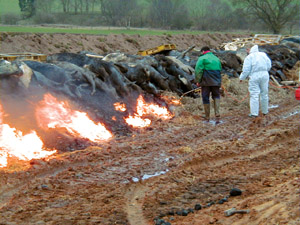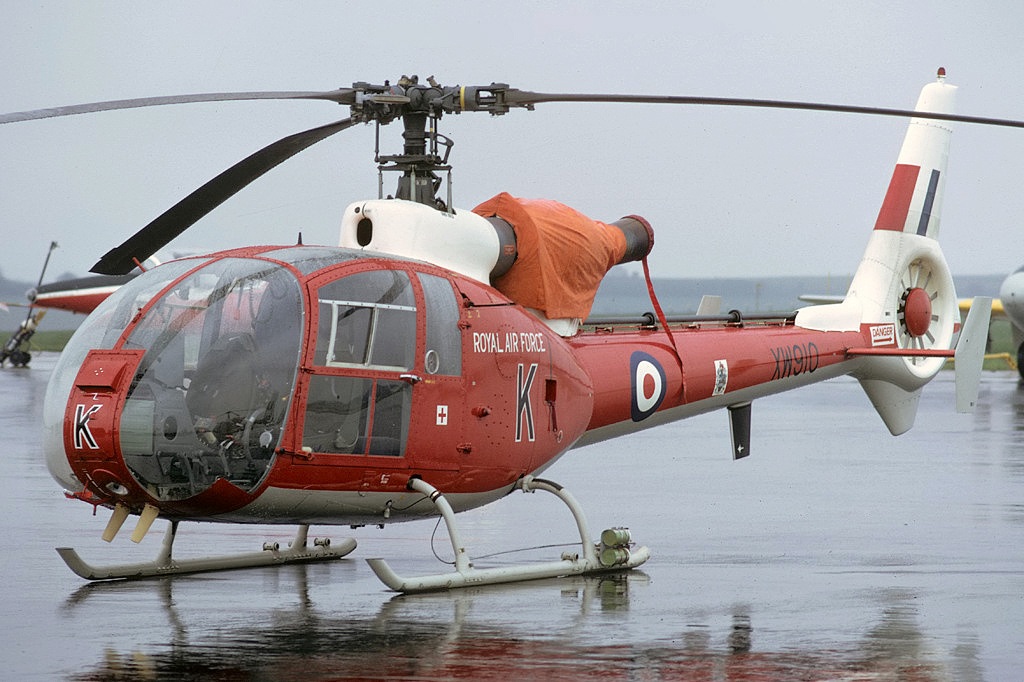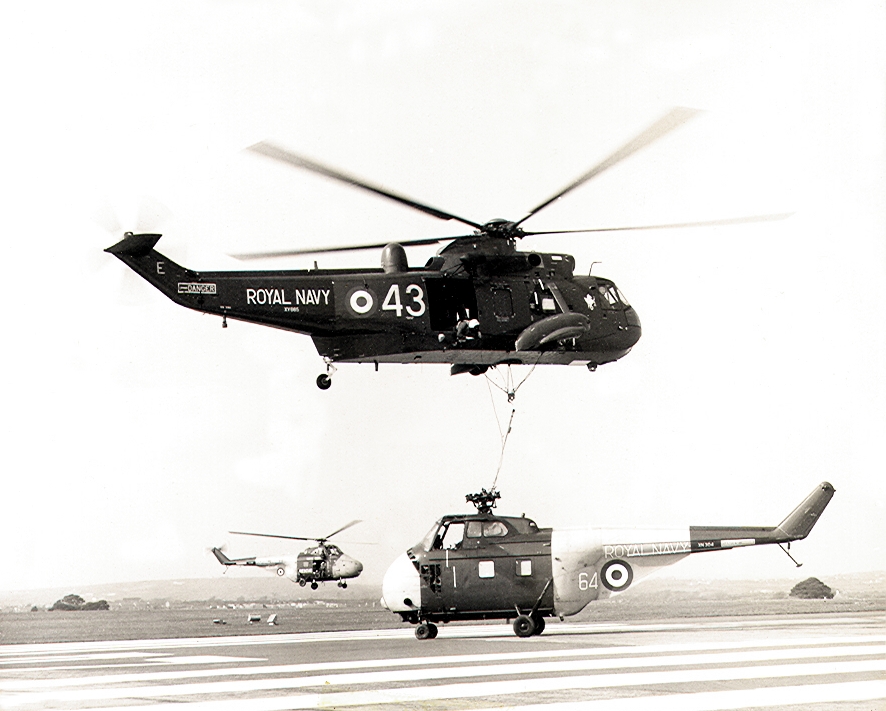|
Ten Tors Challenge
Ten Tors is an annual weekend hike in early May, on Dartmoor, southwest England. Organised by the British Army, starting in 1960, it brings together teams of six young people each, with the 2,400 young participants hiking to checkpoints on ten specified tors. The majority of entrants are schools, colleges, Scout groups and Cadet squadrons from South West England, though groups from across the UK have regularly taken part, as have teams from Australia and New Zealand. However, from 2012, only teams from the South West of England are eligible to take part, due to the large numbers of entrants. Event format Teams of six are required to visit ten specified tors; on the top of each tor is a checkpoint. Each team is required to visit all of the specified checkpoints in order. Up to two members per team may fall out during the Challenge; teams falling below this number could merge in earlier years, while later rules required a badly reduced team to forfeit. There are 26 different ... [...More Info...] [...Related Items...] OR: [Wikipedia] [Google] [Baidu] |
Team Walking Across Dartmoor During Ten Tors
A team is a group of individuals (human or non-human) working together to achieve their goal. As defined by Professor Leigh Thompson of the Kellogg School of Management, " team is a group of people who are interdependent with respect to information, resources, knowledge and skills and who seek to combine their efforts to achieve a common goal". A group does not necessarily constitute a team. Teams normally have members with complementary skills and generate synergy through a coordinated effort which allows each member to maximize their strengths and minimize their weaknesses. Naresh Jain (2009) claims: Team members need to learn how to help one another, help other team members realize their true potential, and create an environment that allows everyone to go beyond their limitations. While academic research on teams and teamwork has grown consistently and has shown a sharp increase over the past recent 40 years, the societal diffusion of teams and teamwork actually foll ... [...More Info...] [...Related Items...] OR: [Wikipedia] [Google] [Baidu] |
Territorial Army (United Kingdom)
The Army Reserve is the active-duty volunteer reserve force of the British Army. It is separate from the Regular Reserve whose members are ex-Regular personnel who retain a statutory liability for service. The Army Reserve was known as the Territorial Force from 1908 to 1921, the Territorial Army (TA) from 1921 to 1967, the Territorial and Army Volunteer Reserve (TAVR) from 1967 to 1979, and again the Territorial Army (TA) from 1979 to 2014. The Army Reserve was created as the Territorial Force in 1908 by the Secretary of State for War, Richard Haldane, when the Territorial and Reserve Forces Act 1907 combined the previously civilian-administered Volunteer Force, with the mounted Yeomanry (at the same time the Militia was renamed the Special Reserve). Haldane planned a volunteer "Territorial Force", to provide a second line for the six divisions of the Expeditionary Force which he was establishing as the centerpiece of the Regular Army. The Territorial Force was to be comp ... [...More Info...] [...Related Items...] OR: [Wikipedia] [Google] [Baidu] |
Death Of Charlotte Shaw
Charlotte Shaw was a fourteen-year-old British schoolgirl who drowned while crossing a swollen stream on Dartmoor during training for Ten Tors in 2007. Her death, the first to occur in connection with Ten Tors or one of its training expeditions, made national news headlines in the United Kingdom. She was with a group of students from Edgehill College trekking the route of Ten Tors in training for the main event when the group got into difficulties crossing a stream. Shaw slipped into the water and was washed downstream. She was located 20 minutes later by a Royal Navy search and rescue helicopter and airlifted to Derriford Hospital in Plymouth, where she died in the early hours of the next morning. A police investigation concluded that nobody should be held criminally responsible for Shaw's death. The investigation was later criticised by the coroner, who adjourned the inquest and recommended that the Crown Prosecution Service (CPS) reconsider the possibility of criminal charges. ... [...More Info...] [...Related Items...] OR: [Wikipedia] [Google] [Baidu] |
2001 UK Foot And Mouth Crisis
The outbreak of foot-and-mouth disease in the United Kingdom in 2001 caused a crisis in British agriculture and tourism. This epizootic saw 2,000 cases of the disease in farms across most of the British countryside. Over 6 million cows and sheep were killed in an eventually successful attempt to halt the disease. Cumbria was the worst affected area of the country, with 893 cases. With the intention of controlling the spread of the disease, public rights of way across land were closed by order. This damaged the popularity of the Lake District as a tourist destination and led to the cancellation of that year's Cheltenham Festival, as well as the British Rally Championship for the 2001 season and delaying that year's general election by a month. Crufts, the dog-based festival had to be postponed by 2 months from March to May 2001. By the time that the disease was halted in October 2001, the crisis was estimated to have cost the United Kingdom £8bn. Background Britain's ... [...More Info...] [...Related Items...] OR: [Wikipedia] [Google] [Baidu] |
Tavistock Times Gazette
''Tavistock Times Gazette'' is a weekly newspaper which serves the Tavistock area in West Devon, England. It is published in tabloid format every Thursday. The paper exists as the result of the merging of two rival papers in 1986. The ''Tavistock Times'', founded in 1920, competed with the older ''Tavistock Gazette'', founded in 1857, and each at various points threatened to put the other out of business. The paper has a circulation of about 8,000, and is owned by the Tindle Newspaper Group
The Tindle Group is a British multimedia company operating regional newspapers and radio stations across the British Isles.
It publishes over 200 local newspa ...
[...More Info...] [...Related Items...] OR: [Wikipedia] [Google] [Baidu] |
Army Air Corps (United Kingdom)
The Army Air Corps (AAC) is a component of the British Army, first formed in 1942 during the Second World War by grouping the various airborne units of the British Army. Today, there are eight regiments (seven Regular Army and one Reserve) of the AAC as well as four Independent Flights and two Independent Squadrons deployed in support of British Army operations around the world. Regiments and flights are located in the United Kingdom, Brunei, Canada, and Germany. Some AAC squadrons provide the air assault elements of 16 Air Assault Brigade through Joint Helicopter Command. History First formation: 1942–1949 The British Army first took to the sky during the 19th century with the use of observation balloons. In 1911 the Air Battalion of the Royal Engineers was the first heavier-than-air British military aviation unit. The following year, the battalion was expanded into the Military Wing of the Royal Flying Corps which saw action throughout most of the First World War unt ... [...More Info...] [...Related Items...] OR: [Wikipedia] [Google] [Baidu] |
Aérospatiale Gazelle
The Aérospatiale Gazelle (company designations SA 340, SA 341 and SA 342) is a French five-seat helicopter, commonly used for light transport, scouting and light attack duties. It is powered by a single Turbomeca Astazou turbine engine and was the first helicopter to feature a fenestron tail instead of a conventional tail rotor. It was designed by Sud Aviation, later Aérospatiale, and manufactured in France and the United Kingdom through a joint production agreement with Westland Aircraft. Further Licensed production, manufacturing under license was performed by SOKO in Yugoslavia and the Arab British Helicopter Company (ABHCO) in Egypt. Since being introduced to service in 1973, the Gazelle has been procured and operated by a number of export customers. It has also participated in numerous conflicts around the world, including by Syria during the 1982 Lebanon War, by Rwanda during the Rwandan Civil War in the 1990s, and by numerous participants on both sides of the 1991 Gulf ... [...More Info...] [...Related Items...] OR: [Wikipedia] [Google] [Baidu] |
39 (Skinners) Signal Regiment
39th (Skinners) Signal Regiment is an Army Reserve regiment in the Royal Corps of Signals in the British Army. The regiment forms part of 1 Signal Brigade, providing military communications for national operations. The Lynx badge is a reminder of the unit's connection with the Worshipful Company of Skinners. History The regiment was formed in 1967 by the amalgamation of 65th Signal Regiment and 92nd Signal Regiment, with some personnel from the disbanded Queen's Own Oxfordshire Hussars at Banbury. In 1971 a new 5 (Banbury) Squadron was formed, which in 1975 became 5 (Queen's Own Oxfordshire Hussars) Signal Squadron. 47 (Middlesex Yeomanry) Signal Squadron at Uxbridge formed part of the regiment from 1995 to 2006, when it transferred to 71st (City of London) Yeomanry Signal Regiment. In 2000, the North Somerset Yeomanry designation was revived for the Headquarters Squadron of 39th (Skinners) Signal Regiment and, in 2008, that squadron, as 93 (North Somerset Yeomanry) Squad ... [...More Info...] [...Related Items...] OR: [Wikipedia] [Google] [Baidu] |
848 Naval Air Squadron
848 Naval Air Squadron was a squadron of the Royal Navy Fleet Air Arm. It operated the Westland Sea King HC.4 helicopter and previously provided advanced flying training to pilots for the other squadrons in the Commando Helicopter Force. The squadron was based at RNAS Yeovilton in Somerset and was decommissioned on 24 March 2016. History Second World War The squadron was officially formed in June 1943 as a torpedo bomber, reconnaissance, Avenger squadron at Quonset Point Naval Air Station, and subsequently embarked on in October 1943, for the UK. Assigned to between 1944 and 1945, 848 Squadron provided air support for the invasion of Okinawa (Operation Iceberg). Whirlwind years The squadron reformed at RNAS Gosport (HMS Siskin) on 29 October 1952 with American-built Westland Whirlwind HAS.21s for work in Malaya. 848 Squadron 26 whirlwind MK 7 aircraft joined HMS ''Bulwark'' in early 1960 and deployed to the Far East for two and a half years - when the ship was in Singapo ... [...More Info...] [...Related Items...] OR: [Wikipedia] [Google] [Baidu] |
Westland Sea King
The Westland WS-61 Sea King is a British licence-built version of the American Sikorsky S-61 helicopter of the same name, built by Westland Helicopters. The aircraft differs considerably from the American version, with Rolls-Royce Gnome engines (derived from the US General Electric T58), British-made anti-submarine warfare systems and a fully computerised flight control system. The Sea King was primarily designed for performing anti-submarine warfare (ASW) missions. A Sea King variant known as the Commando was devised by Westland to serve as a troop transport. In British service, the Westland Sea King provided a wide range of services in both the Royal Navy and the Royal Air Force. As well as wartime roles in the Falklands War, the Gulf War, the Bosnian War, the Iraq War and the Afghanistan War, the Sea King is perhaps most well known in its capacity as a Royal Navy Search and Rescue (red and grey livery) and RAF Search and Rescue Force (yellow livery) helicopter. The S ... [...More Info...] [...Related Items...] OR: [Wikipedia] [Google] [Baidu] |
The Rifles
The Rifles is an infantry regiment of the British Army. Formed in 2007, it consists of four Regular battalions and three Reserve battalions, plus a number of companies in other Army Reserve battalions. Each battalion of The Rifles was formerly an individual battalion of one of the two large regiments of the Light Division (with the exception of the 1st Battalion, which is an amalgamation of two individual regiments). Since formation the regiment has been involved in combat operations, first in the later stages of the Iraq War and in the War in Afghanistan. History The Rifles was created as a result of the Future Army Structure review. Under the original announcement, the Light Division would have remained essentially unchanged, with the exception of the Light Infantry gaining a new battalion through the amalgamation of two other regiments, and both gaining a reserve battalion from within the Territorial Army (TA) as it was then called. However, on 24 November 2005, the Ministr ... [...More Info...] [...Related Items...] OR: [Wikipedia] [Google] [Baidu] |
Rifle Volunteers
The Rifle Volunteers was a regiment of the British Territorial Army. In 2007, it was re-designated as 6th Battalion, The Rifles. History The ''Rifle Volunteers'' were formed in 1999 by the amalgamation of the 6th (Volunteer) Battalion, The Light Infantry, 4th (Volunteer) Battalion, Devonshire and Dorset Regiment and elements of the 2nd (Volunteer) Battalion, Royal Gloucestershire, Berkshire and Wiltshire Regiment in consequence of the reforms implemented due to the Strategic Defence Review. The HQ was in Exeter, and the battalion comprised five rifle companies and a headquarters company, as follows: *HQ Company, at Wyvern Barracks, Exeter *A (The Royal Gloucestershire, Berkshire and Wiltshire Regiment) Company, at Gloucester, Bristol, and Cinderford''(from A and B Companies, 2nd Battalion, Royal Gloucestershire, Berkshire and Wiltshire Regiment)'' *B (Somerset Light Infantry) Company, at Taunton, Yeovil, and Bath''(from HQ and B Companies, 6th Battalion, The Light Infantry)'' *C ... [...More Info...] [...Related Items...] OR: [Wikipedia] [Google] [Baidu] |





